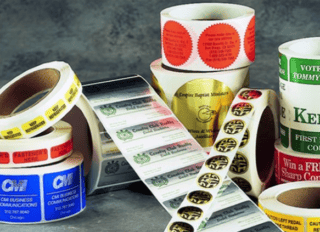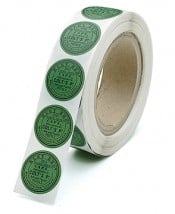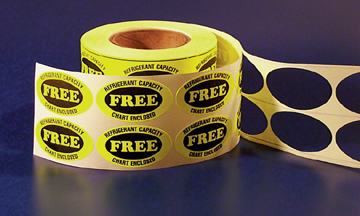Custom printed roll labels are a popular choice for businesses looking to add branding and labeling to their products.
These labels are typically printed on a roll, making them easy to apply using a label dispenser or applicator. They can be customized with a variety of designs, colors, and materials to match the specific needs of the product and brand. Custom printed roll labels are commonly used in industries such as food and beverage, cosmetics, and pharmaceuticals, but can be utilized by any business looking to add a professional touch to their products.
Why Choose Custom Printed Roll Labels?
There are several advantages to choosing custom printed roll labels for your business. First and foremost, they allow for a high level of customization, giving you the ability to create labels that perfectly match your brand’s aesthetic and messaging. Additionally, custom printed roll labels are typically more cost-effective than other labeling options, as they can be printed in bulk and are easy to apply.
They are also versatile, as they can be made with a variety of materials, including paper, vinyl, and polyester, to suit the specific needs of your product. Custom printed roll labels are also durable and long-lasting, ensuring that your branding remains intact even in harsh environments. Finally, they are easy to apply, saving time and increasing efficiency in your labeling process.
Different Finishing Options for Roll Labels?
- Glossy finish: A shiny, reflective finish that gives the label a high-quality and professional look. It is water-resistant and provides a protective layer to the label.
- Matte finish: A non-reflective finish that gives the label a more subtle and sophisticated look. It is ideal for designs that require a muted appearance.
- High gloss UV coating: A glossy finish that is applied to the label after printing and cured with UV light. It provides a high level of protection against fading, scratching, and moisture.
- Soft-touch finish: A velvety, tactile finish that gives the label a luxurious and premium feel. It is ideal for products that require a high-end look and feel.
- Foil stamping: A process that involves applying a metallic or colored foil to the label using heat and pressure. It adds a decorative element to the label and creates a shiny, reflective effect.
- Embossing: A process that involves creating a raised design on the label by pressing it into the material. It adds texture and depth to the label and creates a tactile effect.
- Spot UV coating: A glossy finish that is applied to specific areas of the label to create a contrast between matte and glossy elements. It adds a high-end and eye-catching effect to the label.
- Lamination (gloss or matte): A process that involves applying a thin layer of plastic film over the label to protect it from moisture, fading, and scratching. It also adds a glossy or matte finish to the label.
- Die-cutting: A process that involves cutting the label into a specific shape or design using a custom-made die. It creates a unique and custom look for the label.
- Perforation: A process that involves creating small holes or cuts in the label to make it easy to tear or separate. It is commonly used for labels that need to be removed or opened easily.
- Sequential numbering: A process that involves printing a unique number or code on each label in a sequential order. It is commonly used for tracking and inventory purposes.
- Variable data printing: A process that involves printing different information or designs on each label, such as names, addresses, or barcodes. It is commonly used for personalized or customized labels.

What Material are Custom Printed Roll Labels Made of?
Custom printed roll labels can be made from a variety of materials, depending on the specific needs of the product and brand. The most commonly used materials include paper, vinyl, and polyester. Paper labels are the most cost-effective option and are ideal for indoor use, while vinyl and polyester labels are more durable and suitable for outdoor use. Vinyl labels are resistant to moisture, sunlight, and chemicals, making them a popular choice for products that require a high level of protection. Polyester labels are the most durable option and can withstand extreme temperatures, making them ideal for industrial and automotive applications.
In addition to the material, the adhesive used on the label is also important. There are several types of adhesives available, including permanent, removable, and repositionable. Permanent adhesives are ideal for labels that need to be affixed permanently, while removable and repositionable adhesives are suitable for labels that need to be removed or repositioned without leaving residue.
What Popular Shapes and Sizes Do Roll Labels Come in?
 Custom printed roll labels come in a wide variety of shapes and sizes to suit the specific needs of the product and brand. The most popular shapes for roll labels include circles, squares, rectangles, and ovals. These shapes are versatile and can be used for a variety of applications, from product labeling to packaging and branding. Roll labels are also available in custom shapes, which can be designed to fit the unique dimensions of the product or to create a distinctive look for the brand.
Custom printed roll labels come in a wide variety of shapes and sizes to suit the specific needs of the product and brand. The most popular shapes for roll labels include circles, squares, rectangles, and ovals. These shapes are versatile and can be used for a variety of applications, from product labeling to packaging and branding. Roll labels are also available in custom shapes, which can be designed to fit the unique dimensions of the product or to create a distinctive look for the brand.
In terms of sizes, roll labels can range from small labels that are only a few millimeters in diameter to large labels that are several inches wide. The size of the label will depend on the specific needs of the product and the amount of information that needs to be included on the label.
Is there an Easy Way to Determine What Size Label You Need?
Yes, there are several easy ways to determine what size label you need for your product or project. One way is to measure the area where the label will be applied and determine the maximum size that will fit in that space. Another way is to create a mock-up of the label design and print it on paper or cardstock, then cut it out and test it on the product to determine the ideal size.
Additionally, many label printing companies offer templates and sizing guides that can be downloaded and used to ensure that the label size is correct. These templates provide a visual representation of the label size and can be customized to fit the specific needs of the product or project.
Does It Matter What Direction the Labels Come Off of the Roll?
Yes, it does matter what direction the labels come off of the roll, especially if the labels are being applied by machine. Labels that are wound in the wrong direction can cause jams and other issues during the labeling process, resulting in wasted time and materials. Additionally, labels that are wound in the wrong direction may not adhere properly to the product, resulting in labels that fall off or peel away over time.
To ensure that the labels are wound in the correct direction, it is important to specify the unwind direction when placing the order for custom printed roll labels. The unwind direction is determined by the orientation of the label design and can be specified as either “inside wound” or “outside wound.” By specifying the correct unwind direction, the labels will come off the roll smoothly and adhere properly to the product, resulting in a professional and effective labeling solution.
Can Roll Labels Be Auto-Applied or Auto-Dispensed?
 Yes, roll labels can be auto-applied or auto-dispensed using specialized labeling equipment. Auto-application and auto-dispensing systems are commonly used in manufacturing and packaging facilities to streamline the labeling process and improve efficiency.
Yes, roll labels can be auto-applied or auto-dispensed using specialized labeling equipment. Auto-application and auto-dispensing systems are commonly used in manufacturing and packaging facilities to streamline the labeling process and improve efficiency.
These systems use advanced technology to apply or dispense the labels automatically, without the need for manual intervention. Auto-application systems use a variety of methods to apply the labels, including pressure-sensitive application, blow-on application, and tamp-on application.
Auto-dispensing systems use a motorized dispenser to release the labels from the roll and apply them to the product. These systems can be customized to fit the specific needs of the product and can handle a wide range of label sizes and shapes. By using auto-application or auto-dispensing systems, companies can improve labeling accuracy, reduce labor costs, and increase production speed, resulting in a more efficient and cost-effective labeling solution.
Which Should I Choose – Roll Labels or Sheets?
The choice between roll labels or sheets depends on the specific needs of the product and the labeling process. Roll labels are ideal for high-volume labeling applications where speed and efficiency are important. They are designed to be used with auto-application or auto-dispensing systems and can be applied quickly and accurately. Roll labels are also more cost-effective than sheet labels, as they require less labor and are easier to store and transport.
Sheet labels, on the other hand, are ideal for low-volume labeling applications where flexibility and customization are important. They can be printed in small quantities and can be easily customized to fit the specific needs of the product. Sheet labels are also ideal for manual application, as they can be easily peeled and applied by hand.
Are Sheet or Roll Labels Cheaper?
In general, roll labels are cheaper than sheet labels, especially for high-volume labeling applications. Roll labels are produced using a continuous printing process, which allows for faster production and lower labor costs. The labels are also wound onto a roll, which makes them easier to store and transport, reducing shipping costs. Additionally, roll labels are designed to be used with auto-application or auto-dispensing systems, which further reduces labor costs and increases production speed.
Sheet labels, on the other hand, are produced using a sheet-fed printing process, which is slower and more labor-intensive. Each sheet must be loaded into the printer individually, which increases labor costs and reduces production speed. Sheet labels are also bulkier and more difficult to store and transport, which can increase shipping costs. However, for low-volume labeling applications, sheet labels may be more cost-effective, as they can be printed in small quantities and customized to fit the specific needs of the product.
Can Roll Labels Be Cut into Exact Shape of Your Logo?
Yes, roll labels can be cut into the exact shape of your logo using a process called die cutting. Die cutting is a process that uses a specialized cutting tool, called a die, to cut the label material into a specific shape. The die is created based on the exact specifications of the logo and is used to cut the label material into the desired shape. Die cutting allows for precise and accurate cuts, ensuring that the label fits the logo perfectly. This process is commonly used for custom-shaped labels, such as those with irregular shapes or intricate designs.
What is the Difference Between a Cut Label and a Roll Label?
The main difference between a cut label and a roll label is the way they are produced and supplied. Cut labels are produced individually and supplied in stacks or sheets, while roll labels are produced in a continuous roll and supplied on a spool. Cut labels are typically used for low-volume labeling applications, where each label is printed individually and manually applied to the product. They can be produced in a wide range of sizes and shapes and can be printed on a variety of materials.
Roll labels, on the other hand, are designed for high-volume labeling applications and are typically used with auto-application or auto-dispensing systems. They are produced using a continuous printing process and are supplied on a spool, which makes them easier to store and transport. Roll labels can also be die-cut into custom shapes, which makes them ideal for branding and promotional applications.
Which is the Most Durable Roll Label Material for Food Packaging?
 When it comes to food packaging, the most durable roll label material is typically a synthetic material, such as polyester or polypropylene. These materials are designed to withstand harsh environmental conditions, such as moisture, heat, and chemicals, making them ideal for food packaging applications.
When it comes to food packaging, the most durable roll label material is typically a synthetic material, such as polyester or polypropylene. These materials are designed to withstand harsh environmental conditions, such as moisture, heat, and chemicals, making them ideal for food packaging applications.
Polyester labels, in particular, are known for their durability and resistance to tearing, fading, and smudging. They are also resistant to oils, solvents, and chemicals, which makes them ideal for use in food packaging applications.
Polypropylene labels are also a good option, as they are resistant to water and chemicals, and can withstand exposure to high temperatures. Both polyester and polypropylene labels can be printed with high-quality graphics and text, making them ideal for branding and promotional applications.
Can Roll Labels be Made that will Last in the Freezer?
Yes, roll labels can be made to last in the freezer. Freezer-grade labels are specifically designed to withstand the extreme cold temperatures of a freezer environment, as well as the moisture and condensation that can occur when products are frozen and thawed. These labels are typically made from a synthetic material, such as polypropylene or polyester, which is resistant to water and chemicals and can withstand exposure to low temperatures without cracking or peeling. Freezer-grade labels are also designed with a special adhesive that can withstand the extreme cold temperatures of a freezer environment, ensuring that the label stays in place and remains legible.
How Durable are Custom Printed Roll Labels?
The durability of custom printed roll labels depends on several factors, including the material used, the printing process, and the environmental conditions to which the label will be exposed. Generally, roll labels are designed to be durable and long-lasting, even in harsh environments. They can be printed on a variety of materials, including paper, vinyl, and polyester, each with varying degrees of durability.
Polyester labels, for example, are known for their durability and resistance to tearing, fading, and smudging. They are also resistant to oils, solvents, and chemicals, which makes them ideal for use in industrial and manufacturing applications. Vinyl labels are also durable and resistant to moisture, making them ideal for outdoor applications.
The printing process used to create custom roll labels can also impact their durability. Digital printing is a popular option for custom roll labels, as it produces high-quality graphics and text that are resistant to fading and smudging.
Conclusion
Custom printed roll labels are a versatile and cost-effective labeling solution that can be used in a wide range of applications. Roll labels can be produced in high volumes using a continuous printing process, which allows for faster production and lower labor costs. Whether for industrial, manufacturing, or food packaging applications, they provide a durable and long-lasting labeling solution that can help to promote a brand and enhance the overall appearance of a product.
Popular Posts:




